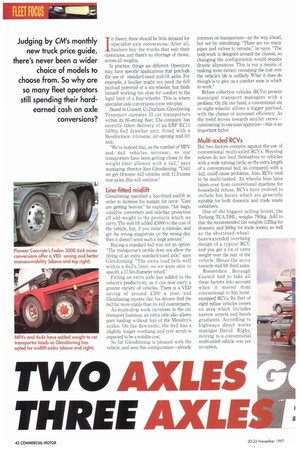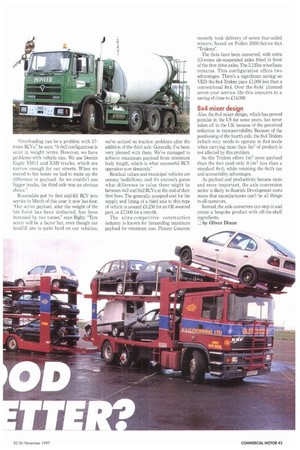FLEET FOCUS 111 •11k,
Page 44

Page 45

If you've noticed an error in this article please click here to report it so we can fix it.
Judging by CM's monthly new truck price guide, there's never been a wider choice of models to choose from. So why are so many fleet operators still spending their hardearned cash on axle conversions?
In theory, there should be little demand for specialist axle conversions. After all, hauliers buy the trucks that suit their operations, and there's no shortage of choice, across all weights.
In practice, things are different Operators may have specific applications that preclude the use of standard-sized mid-lift axles. For example, a haulier might not need the full payload potential of a six-wheeler, but finds himself working too close for comfort to the legal limit of a four-wheeler. This is where specialist axle conversions come into play.
Based in Consett, Co Durham, Glendinning Transport operates 55 car transporters within its 85-strong fleet. The company has recently taken delivery of an ERF ECU 340hp 6x2 drawbar unit, fitted with a Hendrickson 4.0-tonne, air-sprung mid-lift axle.
"We've noticed that, as the number of MPV and 4x4 vehicles increase, so our transporters have been getting closer to the weight limit allowed with a 4x2," says managing director Ken Glendinning. "Until we get 18-tonne 4x2 vehicles with 11.5-tonne rear axles, this will continue."
Line-fitted midlift Glendinning specified a line-fitted midlift in order to increase his margin for error: "Cars are getting heavier," he explains. "Air bags, catalytic converters and side-bar protection all add weight to the products which we carry. The mid-lift added £5000 to the cost of the vehicle, but, if you make a mistake, and get the wrong magistrate on the wrong day, then it doesn't seem such a large amount."
Buying a standard 6x2 was not an option. "The transporter's profile does not allow the fitting of an extra standard-sized axle," says Glendinning. "The extra load falls well within a 6x2's limit, so we were able to specify a 17.5in-diameter wheel."
Fitting an extra axle has added to the vehicle's productivity, as it can now carry a greater variety of vehicles. There is a VED saving of around £300 a year, and Glendinning reports that his drivers find the 6x2 far more stable than its 4x2 counterparts.
As multi-drop work increases in the car transport business, an extra axle also allows part loading without fear of the Ministry's scales. On the downside, the 6x2 has a slightly longer overhang and tyre scrub is expected to be a notable cost.
So far Glendinning is pleased with the vehicle, and sees this configuration—already common on transporters—as the way ahead, but not by retrofitting: "There are too many pipes and valves to reroute," he says. "The bodywork is designed around the chassis, so changing the configuration would require drastic alterations. This is not a means of making more money; recouping the cost over the vehicle's life is unlikely What it does do though is to give us a comfort zone in which to work."
Refuse collection vehicles (RCVs) present municipal transport managers with a problem. On the one hand, a conventional six or eight-wheeler allows a bigger payload, with the chance of increased efficiency. As the trend moves towards smaller crews— culminating in one-man operation—this is an important factor.
Multi-axled RCVs
But two factors conspire against the use of conventional multi-axled RCVs. Housing estates do not lend themselves to vehicles with a wide turning circle, so the extra length of a conventional 6x2, as compared with a 4x2, could cause problems. Also, RCVs tend to be multi-tasked. As wheelie bins have taken over from conventional dustbins for household refuse, RCVs have evolved to include bin hoists which are generally suitable for both domestic and trade waste containers.
One of the biggest selling hoists, the Terberg TCA/DHI., weighs 790kg. Add to that the recommended bin weights (125kg for domestic and 500kg for trade waste), as well as the shortened wheelbase/extended overhang design of a typical RCV, and you get a lot of extra weight over the rear of the vehicle. Hence the move towards mid-lift third axles.
Rossendale Borough Council had to take all these factors into account when it moved from conventional to bin hoistequipped RCVs. Its fleet of eight refuse vehicles covers an area which includes narrow streets and harsh gradients. According to highways direct works manager David Rigby, moving to a conventional multi-axled vehicle was not an option.
"Overloading can be a problem with 17tonne RCVs:" he says. "A 6x2 configuration is safer in weight terms. However, we have problems with vehicle size. We use Dennis Eagle XM11 and XM-9 trucks, which are narrow enough for our streets. When we moved to bin hoists we had to make up the difference in payload. As we couldn't use bigger trucks, the third axle was an obvious choice."
Rossendale put its first mid-lift RCV into service in March of this year: it now has four. "Our active payload, after the weight of the bin hoist has been deducted, has been increased by two tonnes," says Rigby. "Tyre scrub will be a factor but, even though our landfill site is quite hard on our vehicles,
we've noticed no traction problems after the addition of the third axle. Generally, I've been very pleased with them. We've managed to achieve maximum payload from minimum body length, which is what successful RCV operation now demands."
Residual values and municipal vehicles are uneasy bedfellows, and it's anyone's guess what difference in value there might be between 4x2 and 6x2 RCVs at the end of their first lives. The generally accepted cost for the supply and fitting of a third axle to this type of vehicle is around £6,250 for an OE-sourced part, or £7,000 for a retrofit.
The ultra-competitive construction industry is known for demanding maximum payload for minimum cost. Pioneer Concrete recently took delivery of seven four-axled mixers, based on Foden 3000-Series 6x4 "Tridems".
The 6x4s have been converted, with extra 3.5-tonne air-suspended axles fitted in front of the first drive axles. The 5.125m wheelbase remains, This configuration offers two advantages. There's a significant saving on VED: the 8x4 Tridem pays £1,900 less than a conventional 8x4. Over the 8x4s' planned seven-year service life this amounts to a saving of close to £14,000.
8x4 mixer design
Also, the 8x4 mixer design, which has proved popular in the US for some years, has never taken off in the UK because of the perceived reduction in manoeuvrability. Because of the positioning of the fourth axle, the 8x4 Tridem (which only needs to operate in 8x4 mode when carrying more than 5m3 of product) is not affected by this problem.
So the Tridem offers 1m3 more payload than the 6x4 (and only 0.1m3 less than a standard 8x4), while retaining the 8x4's tax and accessibility advantages.
As payload and productivity become more and more important, the axle conversion sector is likely to flourish. Development costs mean that manufacturers can't be all things to all operators.
Instead, the axle converters can step in and create a bespoke product with off-the-shelf ingredients.
by Oliver Dixon
















































































































